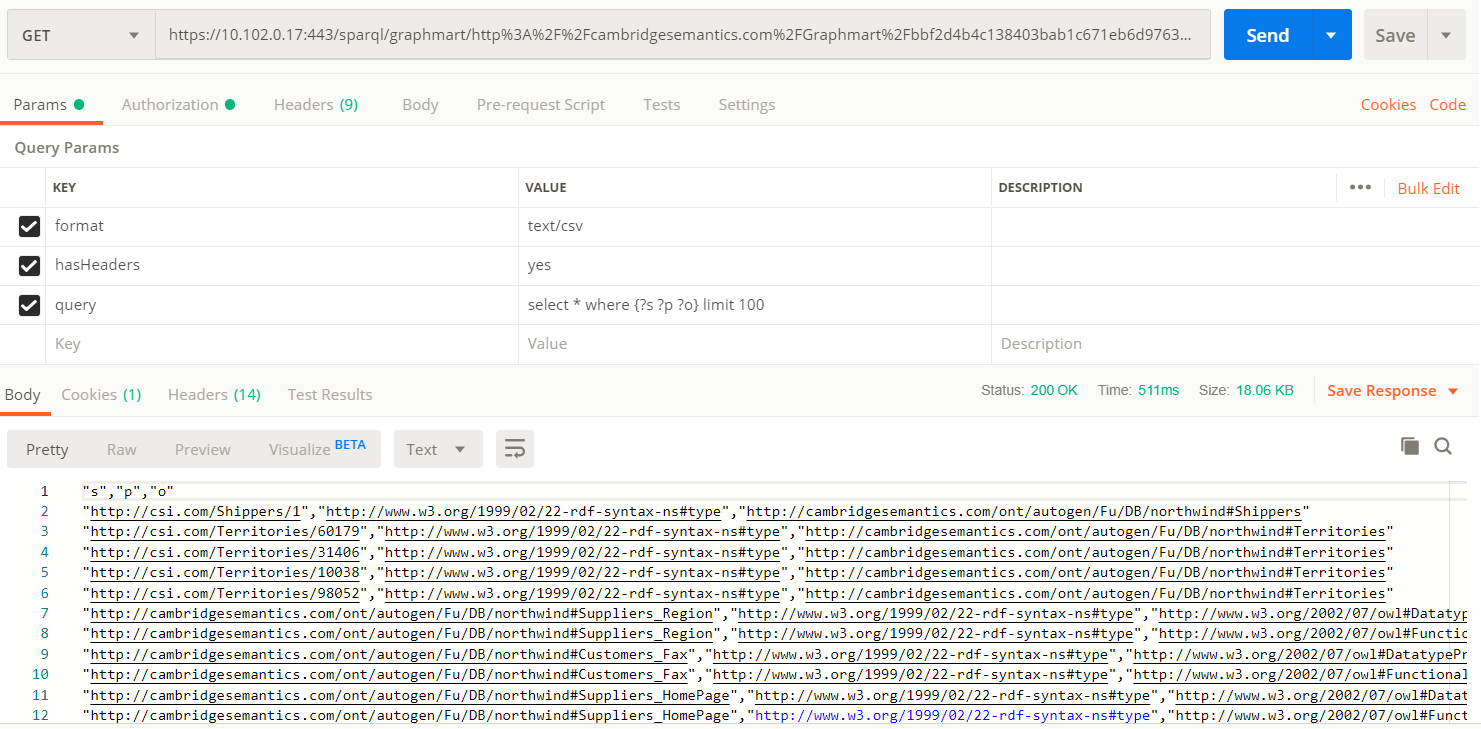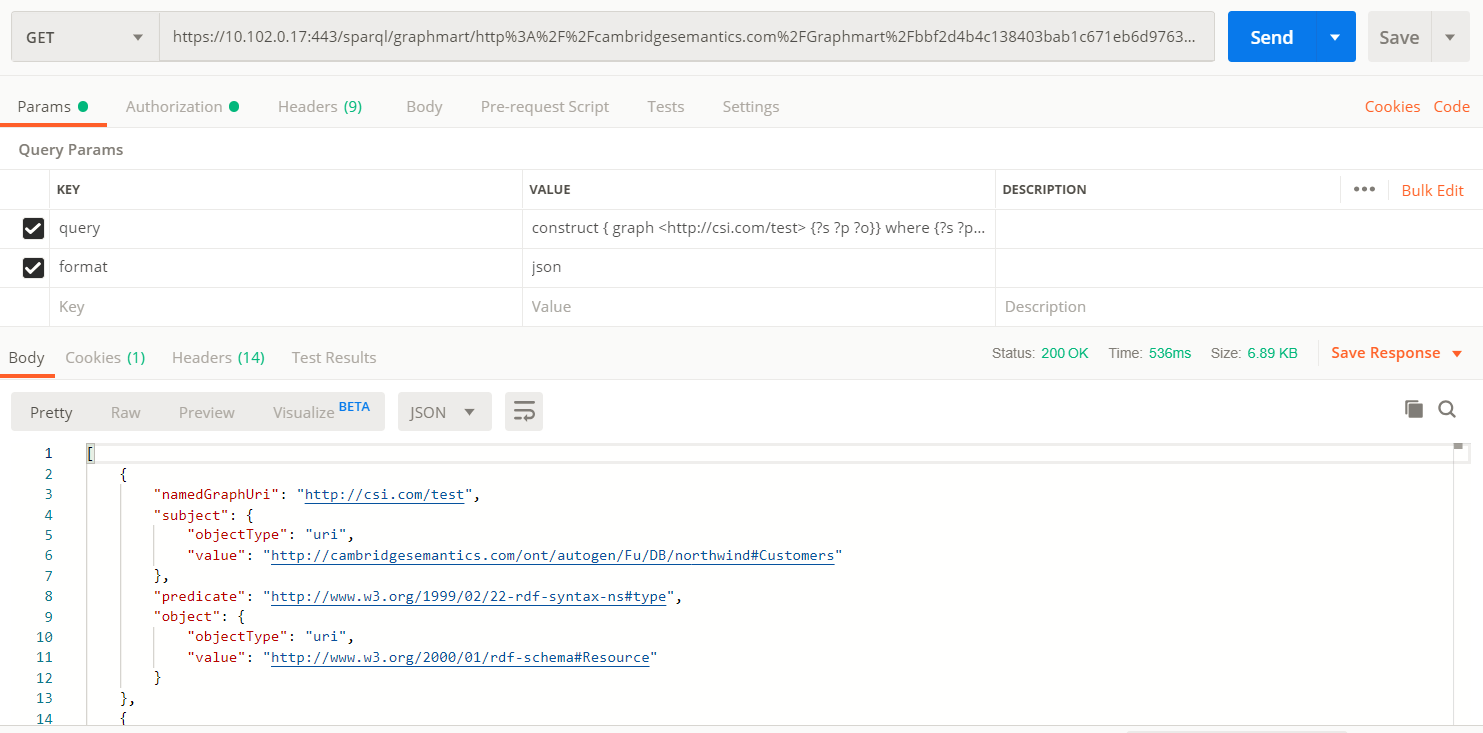Accessing Data from the SPARQL Endpoint
Anzo offers a standard HTTP(S) SPARQL endpoint for sending SPARQL requests between client applications and Anzo. The endpoint is enabled by default. This topic provides the base endpoint URL and describes the supported HTTP methods and parameters.
Authentication
The Anzo SPARQL endpoint supports Basic Authentication. The endpoint can be configured to enable other Anzo-supported authentication methods. However, implementing alternate authentication mechanisms can have unexpected results. For more information, contact Cambridge Semantics Support.
Ultimately the data that is available to users from SPARQL endpoints depends on the access control configuration of the graphmart or linked data set as configured in Anzo.
HTTP Methods and Options
The Anzo SPARQL endpoint accepts HTTP GET and POST methods. GET is used to retrieve data from the endpoint, and POST is used to send data to the endpoint. Update queries must use the POST method, and read queries can be submitted using GET or POST.
Endpoint Base URL
Use the following base URL to access data in Anzo via the SPARQL endpoint. The table below describes each base URL component:
<protocol>://<hostname>:<port>/sparql/<store_type>/<url-encoded_dataset_uri>
For example, the following base endpoint URL targets the data in a graphmart:
https://10.100.10.20:8443/sparql/graphmart/http%3A%2F%2Fcambridgesemantics.com%2FGraphmart%2F1ad0ee911b834097ad7f71ee0ae1c0ff
The example below shows a base endpoint URL that targets a Dataset catalog entry:
https://10.100.10.20:8443/sparql/lds/http%3A%2F%2Fopenanzo.org%2FcatEntry(%255Bhttp%253A%252F%252Fcsi.com%252FFileBasedLinkedDataSet%252F001e517db4f0eaea9f279427e4e2a828%255D%2540%255Bhttp%253A%252F%252Fopenanzo.org%252Fdatasource%252FsystemDatasource%255D)
HTTP Header Options
The HTTP header provides information related to the transfer of data between the requesting client and the SPARQL endpoint. The table below describes the supported HTTP header options. Both of the fields are optional.
| Option | Description |
|---|---|
| Content-Type | The Content-Type specifies the type of request that is being sent by the client. Anzo supports the following Content-Type values:
|
| Accept | The Accept field specifies the response formats that are acceptable for the server to send back to the client. You can use this field to specify the output serialization format for query results in place of the format HTTP parameter. For details about the supported formats, see Format Options below. |
HTTP Body Parameters
The HTTP parameters in the body of the request provide the rest of the information about the request. Certain parameters are appropriate for read-only queries, SELECT and CONSTRUCT, and others are appropriate for updates, INSERT and DELETE. The tables below describe the supported parameters for query and update requests.
Query Parameters
| Parameter | Description |
|---|---|
| query | Specifies the full read-only query string to run. If you do not specify a url-encoded_dataset_uri, default-graph-uri or named-graph-uri in the request, the query string should contain the appropriate FROM clauses. To run an update query (INSERT or DELETE), use the update parameter. |
| default-graph-uri | Specifies a default graph URI to query. You can include this parameter multiple times in a request. When the base URL specifies a graphmart URI, you can specify a data layer URI to narrow the scope of the query to a specific data layer in the graphmart. |
| named-graph-uri | Specifies a named graph URI to query. You can include this parameter multiple times in a request. When the base URL specifies a graphmart URI, you can specify a data layer URI to narrow the scope of the query to a specific data layer in the graphmart. |
| format | Specifies the serialization format to use for the results of the query. For details about the supported formats, see Format Options below. |
| includeMetadataGraphs | A boolean value that specifies whether to query the metadata graphs. Only valid for queries that target a linked data set (LDS) that is stored in a local volume. The default value is includeMetadataGraphs=false. |
| delim | Specifies a custom delimiter character to use in CSV output results. Valid only for SELECT queries where the output format is text/csv. This field accepts any character. When delim is not specified the default value is a , (comma). |
| dedup | A boolean value that specifies whether to deduplicate CONSTRUCT results on the client side. When dedup is not specified, the default value is dedup=true. |
| serverDedup | A boolean value that specifies whether to deduplicate CONSTRUCT results on the server side. When serverDedup is not specified, the default value is serverDedup=true. |
| skipCache | A boolean value that specifies whether to skip the reuse of any query cache that exists from a previous run of the query. When skipCache is not specified, the default value is skipCache=false. |
| hasHeader | A boolean value that specifies whether to include headers in CSV results. Valid only for SELECT queries where the output format is text/csv. When hasHeader is not specified, the default value is hasHeader=false. |
| attachResult | A boolean value that specifies whether to provide the query response as a file "attachment," i.e. the HTTP response will include the Content-Disposition of attachment. When attachResult is not specified, the default value is attachResult=false. When returning results as an attachment, you can specify a file name in filename the parameter. |
| filename | If attachResult is true, this parameter specifies the file name to use for the attachment, excluding the file extension. If attachResult is true and filename is not specified, the default file name is QueryResult. |
Format Options
The table below describes the options for specifying the serialization format of the results that the server sends back to the client. These format options, i.e., MIME types or file extensions, can be specified in the format parameter in the body of the request or in the Accept header.
When the request does not include the format parameter or Accept header, the default result format for SELECT queries is SPARQL XML (application/sparql-results+xml). For CONSTRUCT queries, the default format depends on whether the query includes GRAPH clauses. If no GRAPH clause is present, the default format for CONSTRUCT results is RDF Turtle. If GRAPH clauses are present, the default format is RDF TriG.
| Format | Accepted Values | Query Type | Description |
|---|---|---|---|
| XML | application/sparql-results+xml
application/xml xml xml2 srx |
SELECT only | Returns results in SPARQL Query Results XML Format. |
| application/rdf+xml
rdf owl rdfs |
CONSTRUCT only | Returns results in RDF 1.1 XML format. | |
| JSON | application/json
json |
SELECT and CONSTRUCT | For SELECT queries, results are returned in SPARQL Query Results JSON Format. For CONSTRUCT queries, results are returned in Anzo's native JSON RDF serialization format. See Anzo JSON RDF Serialization for details. |
| application/sparql-results+json | SELECT only | Returns results in SPARQL Query Results JSON Format. | |
| CSV | text/csv
csv |
SELECT only | Returns results in SPARQL Query Results CSV Format. |
| TriG and Gzipped TriG |
application/x-trig
trig application/x-trigz trigz gz trig.gz |
CONSTRUCT only | CONSTRUCT queries with a GRAPH clause return RDF 1.1 TriG by default if no format is specified. |
| Turtle and Gzipped Turtle |
application/x-turtle ttl application/x-turtlez ttlz ttl.gz |
CONSTRUCT only | Returns RDF 1.1 Turtle. CONSTRUCT queries without a GRAPH clause return Turtle by default if no format is specified. |
| N-Triples | text/plain
nt |
CONSTRUCT only | Returns results in RDF 1.1 N-Triples format. |
| Notation3 and Gzipped Notation3 |
text/rdf+n3
n3 text/rdf+n3z n3z n3z.gz |
CONSTRUCT only | Returns results in RDF Notation3 format. |
| N-Quads | text/x-nquads
nq nquad nquads |
CONSTRUCT only | Returns results in RDF 1.1 N-Quads format. |
| TriX | application/trix
trix |
CONSTRUCT only | Returns results in RDF Triples in XML format. |
Update Parameters
| Parameter | Description |
|---|---|
| update | Specifies the full update string to run. If you do not specify a url-encoded_dataset_uri, using-graph-uri or using-named-graph-uri in the request, the update query should contain the appropriate USING clauses. To run a non-update query (SELECT or CONSTRUCT), use the query parameter. |
| using-graph-uri | Specifies a default graph URI to update. You can include this parameter multiple times in a request. When the base URL specifies a graphmart URI, you can specify a data layer URI to narrow the scope of the update to a specific data layer in the graphmart. |
| using-named-graph-uri | Specifies a named graph URI to update. You can include this parameter multiple times in a request. When the base URL specifies a graphmart URI, you can specify a data layer URI to narrow the scope of the update to a specific data layer in the graphmart. |
| includeMetadataGraphs | A boolean value that specifies whether to query the metadata graphs. Only valid for queries that target a linked data set (LDS) that is stored in a local volume. The default value is false. |
Examples
The following example uses cURL to send a request that runs a SELECT query against a graphmart. Since the request does not include an Accept header or format parameter, results will be returned in SPARQL XML format.
curl --user sysadmin:@nz0 -c cookiejar.txt -L -v -k
http://10.100.10.20/sparql/graphmart/http%3A%2F%2Fcambridgesemantics.com%2FGraphmart%2F2dc579b101654ae29eb91b0c7d046ca1
--data-urlencode "query=SELECT * WHERE{ ?s ?p ?o . } LIMIT 100"
The following example sends a GET request that runs a SELECT query against a graphmart. The format parameter is included to format the results in text/csv serialization.

For reference, below is the URL-encoded version of the request string shown in the image above. When sending a request from a client that does not automatically encode requests, you must convert the string. Line breaks are added for readability:
http://10.100.10.20/sparql/graphmart/http%3A%2F%2Fcambridgesemantics.com%2F Graphmart%2F646861d1bab54d67bc79dea94e02f3e6 ?query=select%20*%20where%20%7B%3Fs%20%3Fp%20%3Fo%7D%20limit%20100
The example below sends a POST request that runs a SELECT query. In this example, the query is included in the body of the request and the response format is XML.

The example below sends a GET request that runs a CONSTRUCT query. The response format is set to JSON, and the results are formatted in Anzo JSON RDF Serialization.

The example below uses a Python script to send a request that runs a SPARQL query.
import requests
import urllib
server = 'https://company.anzo.com:'
port = 443
graphmart = 'http://cambridgesemantics.com/Graphmart/be4bd080c5654628b6fff90ca1b647d6'
url = server + str(port) + '/sparql/graphmart/' + urllib.quote_plus(graphmart) #urllib.parse.quote_plus(graphmart) in Python 3
queryText = 'SELECT * WHERE {?instance a ?type .} LIMIT 10'
payload = {'query':queryText, 'format':'text/csv'}
r = requests.post(url, data = payload, auth = ('sysadmin','<pw>'))
print r.text